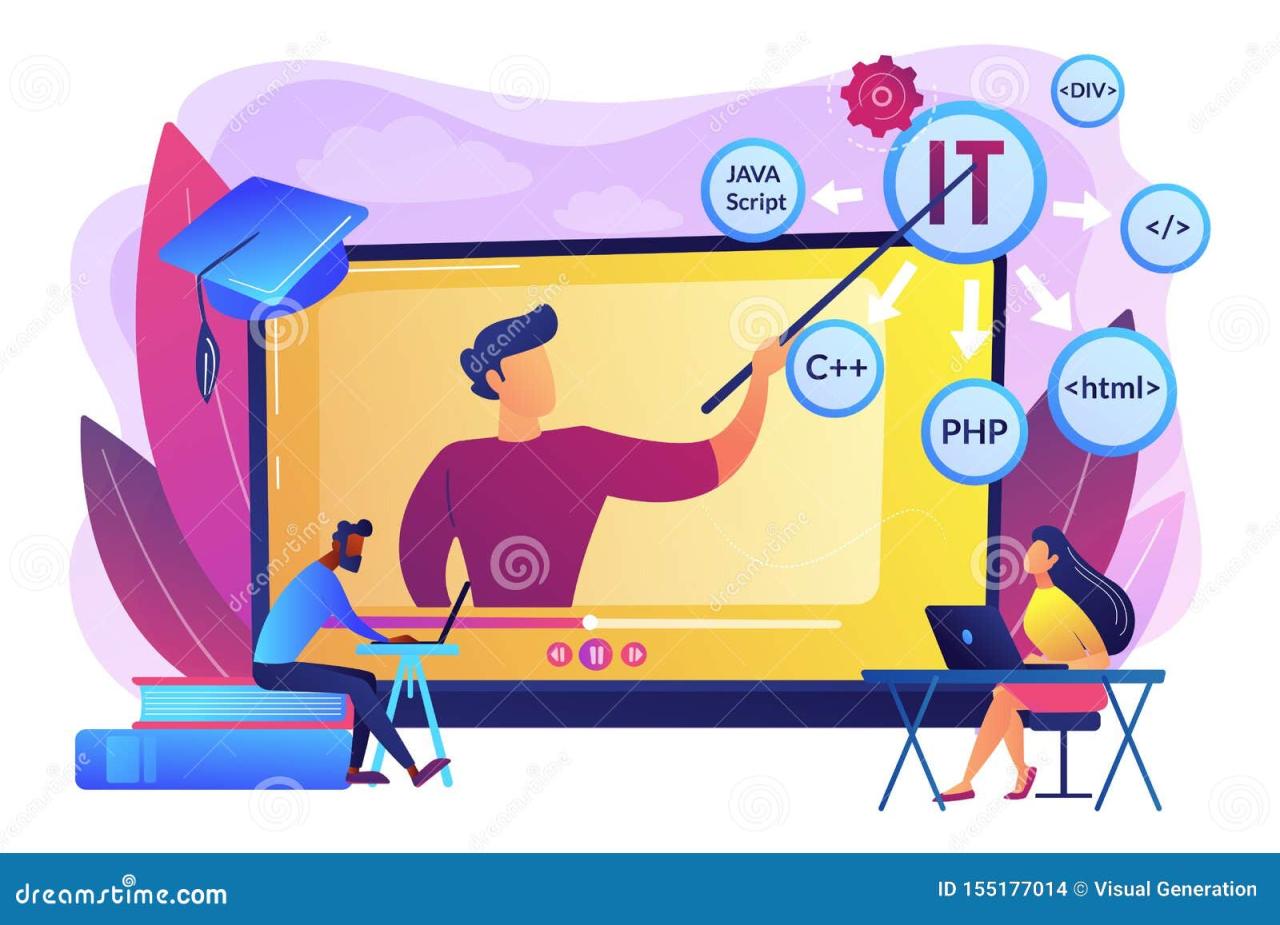IT courses offer a gateway to exciting careers in technology. Whether you’re a complete beginner or looking to upskill, a wide range of courses are available, from short certificates to full degrees, covering everything from networking and cybersecurity to software development and data analysis. This guide explores the diverse world of IT training, helping you navigate the options and choose the path that’s right for you.
We’ll delve into curriculum details, cost comparisons, and the importance of certifications, providing you with the information needed to make informed decisions about your IT education. We’ll also look at the future of IT training and how emerging technologies are shaping the landscape.
So you’re thinking about IT courses? Picking the right one can be a real game-changer, just like how a key player can shift the momentum of a match. Check out this article about how an Atletico Madrid star fires a La Liga title warning: Atletico Madrid star fires La Liga title warning , it shows how a strong individual performance can impact the overall outcome.
Similarly, a solid IT course can propel your career forward, setting you up for success.
Types of IT Courses
The IT industry offers a wide variety of courses catering to different skill levels and career aspirations. Understanding the distinctions between these courses is crucial for making informed decisions.
Categorized List of Common IT Courses
This table provides a snapshot of common IT courses, categorized for clarity. Note that durations are approximate and can vary based on the institution and intensity of the program.
| Course Category | Course Name | Description | Typical Duration |
|---|---|---|---|
| Networking | CCNA (Cisco Certified Network Associate) | Covers networking fundamentals, including routing, switching, and network security. | 6-12 months |
| Cybersecurity | CompTIA Security+ | Focuses on foundational cybersecurity concepts and practices. | 3-6 months |
| Software Development | Introduction to Java Programming | Teaches the basics of Java programming, including object-oriented programming principles. | 3-6 months |
| Data Science | Python for Data Analysis | Introduces Python programming for data manipulation, analysis, and visualization. | 3-6 months |
| Cloud Computing | AWS Certified Cloud Practitioner | Provides an overview of Amazon Web Services (AWS) cloud computing services. | 1-3 months |
Differences Between Certificate, Diploma, and Degree-Level IT Courses
IT courses are offered at various levels, each with distinct features and career implications.
- Certificate Programs: Typically focus on specific skills or technologies, offering shorter durations and a faster path to entry-level positions. They often require less prior knowledge.
- Diploma Programs: Provide a more comprehensive understanding of a particular IT area, often building upon certificate-level knowledge. They usually involve a longer duration and lead to more advanced roles.
- Degree Programs (Associate’s, Bachelor’s, Master’s): Offer the most in-depth education, covering a broad range of IT concepts and often including specialized tracks. They are ideal for long-term career growth and advanced positions.
Career Paths Associated with IT Courses
The career paths following IT courses vary widely depending on the specific course and level of education.
- Networking: Network Administrator, Network Engineer, Systems Administrator
- Cybersecurity: Security Analyst, Penetration Tester, Cybersecurity Architect
- Software Development: Software Developer, Web Developer, Mobile App Developer
- Data Science: Data Analyst, Data Scientist, Machine Learning Engineer
- Cloud Computing: Cloud Architect, Cloud Engineer, DevOps Engineer
Curriculum and Skills Development
A well-structured curriculum and the development of essential soft skills are vital for success in the IT field. The combination of technical expertise and interpersonal skills makes for a well-rounded IT professional.
Sample Curriculum for a Beginner-Level Networking Fundamentals Course
This curriculum focuses on practical application and foundational knowledge.
- Introduction to Networking Concepts
- IP Addressing and Subnetting
- Routing Protocols (RIP, OSPF)
- Switching Technologies (VLANs, STP)
- Network Security Basics (Firewalls, Intrusion Detection)
- Hands-on Lab Exercises and Projects
Essential Soft Skills for Success in the IT Industry
Technical skills are only half the battle; strong soft skills are equally important for career advancement.
- Problem-solving
- Communication (written and verbal)
- Teamwork
- Time management
- Adaptability
- Critical thinking
Comparison of Skills Gained from Online vs. In-Person IT Courses
Both online and in-person courses offer advantages and disadvantages regarding skill development.
- Online Courses: Often provide flexibility and accessibility but may lack the hands-on interaction and immediate feedback of in-person learning.
- In-Person Courses: Offer direct interaction with instructors and peers, facilitating collaborative learning and immediate problem-solving, but may be less flexible in terms of scheduling and location.
Cost and Accessibility of IT Courses

The cost and accessibility of IT courses vary significantly depending on factors such as the institution, course type, and delivery method. Ensuring accessibility for individuals with disabilities is crucial for inclusivity.
Examples of Various Pricing Models for IT Courses
Many different payment options are available to make IT education more accessible.
- One-time Fee: A single payment for the entire course.
- Subscription Model: Monthly or annual payments for access to course materials and resources.
- Installment Plans: Spreading the cost over several months or years.
- Scholarships and Financial Aid: Many institutions offer financial assistance to eligible students.
Accessibility of IT Courses for Individuals with Disabilities
Adaptive learning technologies are essential to ensure inclusivity.
- Screen readers: For visually impaired learners.
- Text-to-speech software: For learners with reading difficulties.
- Closed captions and transcripts: For learners with hearing impairments.
- Alternative input methods: For learners with motor impairments.
Comparison Table of Costs of Different IT Courses from Various Providers
Costs can vary greatly depending on factors like course length, provider reputation, and the specific skills taught.
| Provider | Course Name | Course Type | Approximate Cost |
|---|---|---|---|
| Udemy | Complete Python Bootcamp | Online Course | $100 – $200 |
| Coursera | Google IT Support Professional Certificate | Online Certificate Program | $40 – $50 per month |
| Local Community College | Networking Fundamentals | In-Person Course | $1000 – $2000 per semester |
| Online Bootcamp | Full Stack Web Development | Intensive Online Bootcamp | $10,000 – $20,000 |
Choosing the Right IT Course
Selecting the appropriate IT course requires careful consideration of several key factors to ensure alignment with career goals and learning preferences.
Thinking about IT courses? A solid foundation in science and math is often helpful, much like the prerequisites for other specialized programs. For instance, if you’re considering a career change, check out the surgical tech program admission requirements and prerequisites to see what kind of background they look for. Understanding these requirements can help you plan your IT course selections, ensuring you build a relevant skillset.
Key Factors to Consider When Selecting an IT Course

A thoughtful approach to course selection is crucial for success.
- Career Goals: Identify your desired career path and choose a course that aligns with those goals.
- Learning Style: Consider whether you prefer online, in-person, or blended learning environments.
- Budget: Determine your budget and explore various financing options.
- Course Content: Ensure the course curriculum covers the necessary skills and knowledge.
- Instructor Expertise: Research the instructor’s qualifications and experience.
Step-by-Step Guide on Researching and Evaluating Different IT Course Providers
Thorough research is essential to make an informed decision.
- Identify potential providers: Search online, check industry directories, and ask for recommendations.
- Compare course curricula: Evaluate the content, depth, and relevance of each course.
- Review student testimonials and feedback: Look for reviews and ratings from previous students.
- Assess instructor qualifications: Verify the instructors’ expertise and experience.
- Check accreditation and certifications: Ensure the provider and/or course are recognized by relevant organizations.
Assessing the Credibility and Reputation of an IT Training Institution
Look for indicators of a reputable institution.
- Accreditation: Check for accreditation from recognized bodies.
- Industry partnerships: Look for connections with major tech companies.
- Placement rates: Inquire about job placement success rates for graduates.
- Online reviews and testimonials: Look for honest and unbiased reviews.
Future Trends in IT Training
The IT landscape is constantly evolving, necessitating continuous adaptation in training methodologies and curriculum design. Cybersecurity is increasingly crucial.
Emerging Technologies and Their Impact on the IT Training Landscape
New technologies necessitate updated training programs.
- Artificial Intelligence (AI): AI-powered learning platforms and personalized learning experiences are becoming more prevalent.
- Virtual and Augmented Reality (VR/AR): Immersive training simulations offer realistic and engaging learning environments.
- Blockchain Technology: Courses incorporating blockchain principles and applications are gaining traction.
Increasing Importance of Cybersecurity Training Within IT Courses
Cybersecurity is now a fundamental aspect of most IT roles.
With the increasing sophistication of cyber threats, cybersecurity training is no longer optional but essential across all IT disciplines. Courses now integrate security best practices from the outset, rather than treating it as a separate module.
Potential Future Trends in IT Education
The future of IT education is likely to involve a mix of technological advancements and pedagogical innovations.
- Microlearning: Short, focused learning modules tailored to specific skills.
- Gamification: Incorporating game mechanics to enhance engagement and motivation.
- Personalized Learning Paths: Adaptive learning platforms that cater to individual learning styles and paces.
- Increased Focus on Soft Skills: Greater emphasis on developing crucial soft skills alongside technical proficiencies.
IT Course Delivery Methods: It Courses
Various delivery methods exist, each with its strengths and weaknesses. Choosing the right method depends on individual learning preferences and circumstances.
Comparison of Different Methods of IT Course Delivery

A comparison of online, in-person, and blended learning approaches.
- Online Learning:
- Advantages: Flexibility, accessibility, cost-effectiveness.
- Disadvantages: Requires self-discipline, potential for isolation, limited hands-on interaction.
- In-Person Learning:
- Advantages: Direct interaction with instructors and peers, immediate feedback, hands-on experience.
- Disadvantages: Less flexible scheduling, geographical limitations, potentially higher cost.
- Blended Learning:
- Advantages: Combines the benefits of both online and in-person learning, offers flexibility with structured interaction.
- Disadvantages: Requires careful coordination, may require more resources.
Hypothetical Online IT Course Module: Networking Fundamentals
This module incorporates interactive elements for a dynamic learning experience.
- Introduction to Networks (Video Lecture): A concise video lecture covering basic networking concepts.
- Interactive Quiz: A short quiz to test understanding of the lecture material.
- Hands-on Lab Simulation (Virtual Environment): A virtual lab where students can configure network devices and practice subnetting.
- Discussion Forum: A platform for students to ask questions and collaborate on problem-solving.
- Assignment: A practical assignment requiring students to design a simple network topology.
The Role of Certifications in IT
Industry-recognized certifications play a significant role in demonstrating competency and enhancing career prospects within the IT sector.
Significance of Industry-Recognized Certifications in IT Careers
Certifications validate skills and increase employability.
Certifications act as verifiable proof of skills and knowledge, setting candidates apart from others. They are particularly valuable in competitive job markets and often a requirement for specific roles.
So you’re looking at IT courses? Great choice! There’s a ton of cool stuff you can learn, and many areas are booming right now. For example, you could explore the exciting world of audio engineering, which often involves working with tools like an ai voice generator for creating realistic voiceovers. This skillset is highly valuable in many IT fields, so definitely consider adding it to your skillset.
Mastering this technology will give you a real edge in the job market for IT courses.
Examples of Popular IT Certifications and Their Respective Value in the Job Market
Various certifications cater to different specializations and skill levels.
- CompTIA A+: Entry-level certification for IT support professionals.
- CompTIA Network+: Certification for network technicians and administrators.
- Cisco CCNA: Widely recognized certification for Cisco networking professionals.
- Microsoft Certified: Azure Solutions Architect Expert: A certification for cloud architects specializing in Microsoft Azure.
Table Showcasing Various IT Certifications, Their Requirements, and Associated Job Roles
This table highlights some key certifications and their associated career paths.
| Certification | Requirements | Job Roles |
|---|---|---|
| CompTIA Security+ | Passing the Security+ exam | Security Analyst, Systems Administrator |
| AWS Certified Solutions Architect – Associate | Experience with AWS services and passing the exam | Cloud Architect, Cloud Engineer |
| Google Cloud Certified Professional Cloud Architect | Experience with Google Cloud Platform and passing the exam | Cloud Architect, DevOps Engineer |
| Certified Ethical Hacker (CEH) | Passing the CEH exam | Penetration Tester, Security Analyst |
Ending Remarks
Choosing the right IT course is a significant step towards a rewarding career. By carefully considering your goals, learning style, and budget, and by researching reputable training providers, you can confidently embark on your journey into the dynamic world of technology. Remember to explore different delivery methods, consider the value of certifications, and stay updated on emerging trends to maximize your success.
Answers to Common Questions
What is the average salary after completing an IT course?
Salaries vary greatly depending on the specific course, skills gained, and experience. Entry-level positions can range from $40,000 to $70,000 annually, with potential for significant increases with experience and specialization.
How long does it take to complete an IT course?
Course durations vary widely, from a few weeks for short certificates to several years for degree programs. Consider your time commitment and learning pace when selecting a course.
Are IT courses only for young people?
Absolutely not! People of all ages and backgrounds can benefit from IT courses. Many professionals switch careers or upskill later in life through IT training.
Can I get financial aid for IT courses?
Many institutions offer financial aid, scholarships, and loan options. Check with the specific course provider and explore government resources for potential assistance.
